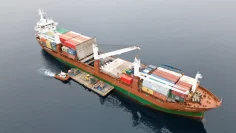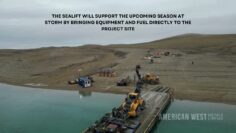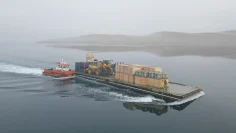{australien_flagge}The Australian market today acknowledged the extension of American West’s spectacular copper discovery at its Storm project on Somerset Island in Nunavut, Canada, with another 17.2 percent increase in the share price. Trading volume reached just under A$20 million on about 65 million shares traded. The closing price was quoted at A$0.34.
CONCLUSION: The news behind today’s discovery is that American West appears to have cracked the code on the Storm deposit. The new drill results impressively confirm that the geophysical techniques used are reliable tools for finding copper sulfides at Storm. The size and intensity of the mineralization in the new zone, which has been named “Thunder”, is even more thick and intense than that of the known high-grade 2750N and 2200N zones along strike to the east, which returned as much as 41m at 4.18% Cu in ST22-05 last year. American West geologists now believe that the Southern Graben Fault is the primary source of near surface and deeper copper mineralization. For this reason, the company is already planning additional drilling along the 10-kilometer-long fault structure next spring. In that sense, the discovery at Storm is just getting started. Meanwhile, American West is awaiting further results from ongoing reserve circulation (RC) drilling from the 2750N and 2200N zones. These near-surface copper targets, aswell as the new Thunder zone, could be suitable for open pit mining and direct-shipping ore, respectively. The company also plans to provide an update on this shortly.
The Australian market today acknowledged the extension of American West’s spectacular copper discovery at its Storm project on Somerset Island in Nunavut, Canada, with another 17.2 percent increase in the share price. Trading volume reached just under A$20 million on about 65 million shares traded. The closing price was quoted at A$0.34.
American West’s third diamond drill hole, ST23-03, actually made two new discoveries in a previously under-explored area of the Storm project: the upper part of the hole hit a new, significant near-surface zone of mineralization, and at depth the hole again intersected – as hoped – a sediment-bound copper system at a similar target depth as previous diamond drilling. Because of its outstanding strength, the new near-surface discovery was christened “Thunder”. Between 32 m and 108 m, visible strong breccias to massive copper sulphide (chalcocite, bornite and chalcopyrite) were encountered in hole ST23-03. The deeper intersection contained 2 m of visible breccia and dense copper sulfide (chalcocite, bornite and chalcopyrite) between 273 m and 275 m hole depth. The deeper intersection correlates with the prospective sedimentary copper horizon intersected earlier this season and is the first recorded occurrence of sedimentary copper south of the Southern Graben Fault (see Figures 1 and 2). Laboratory evaluation of the drill hole is pending. Meanwhile, diamond drilling continues on other high-priority copper targets.
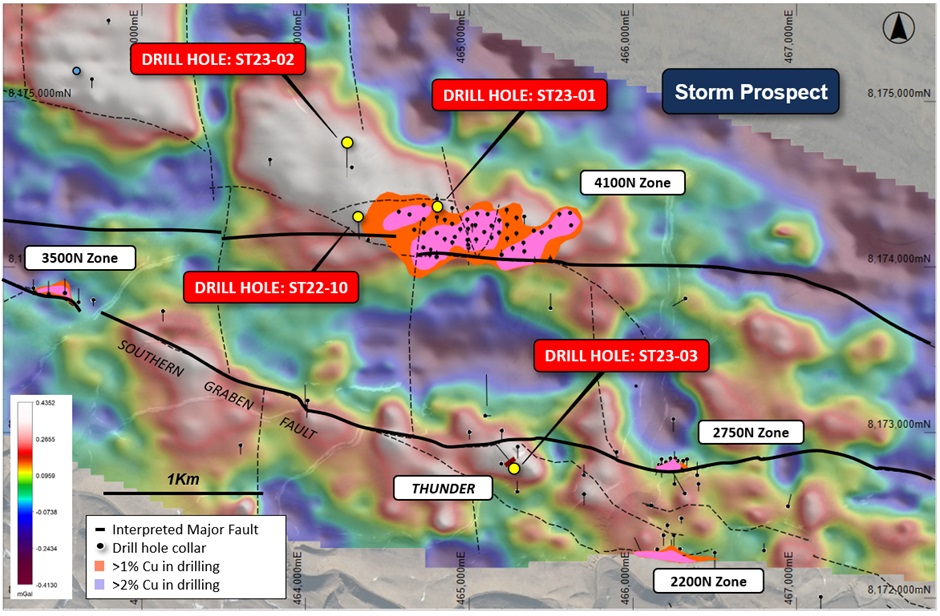
Figure 1: Total bouguer gravity image of the Storm area. Previous diamond drill holes ST23-01 and ST23-02 have focused on the North Trench Fault. Well ST23-03 was the first deep diamond well drilled on the southern Graben fault. This makes the new discovery on Thunder 1 km west of the 2750N high grade copper zone all the more significant.

Figure 2: NW-SE geological section through drill hole ST23-03.
Dave O’Neill, Managing Director of American West Metals, commented, “Diamond drilling at Storm continues to be successful and has produced one of the best intersections ever seen on the project. The third diamond drill hole, ST23-03, intersected over 76 m of near surface breccia copper sulphides with zones of massive sulphides. The hole also intersected – for the first time – copper sulphides within the deeper horizon near the southern trench fault, confirming the presence of the sedimentary system in new and untested areas. The new near-surface copper zone has been christened Thunder, underscoring the strength and significance of the discovery. The mineralization style and setting are very similar to the high grade mineralization within the 2750N Zone, including hole ST22-05 which returned 41m at 4.18% Cu. The 2750N zone is located over 1 km east of Thunder. The thickness of the near-surface intercept – which contains massive copper sulphides – indicates the potential for a significant volume of copper in the area, which could significantly expand the open pit resources at Storm.
The deeper copper intercept is significant in understanding the overall copper resource at Storm. This confirms the recoverability of the entire area around and south of the southern rift valley. With each widely spaced drill hole encountering the same mineralized unit at depth, the size potential of the copper system cannot be overstated. Given the success of gravity modeling and targeting to date, we will prioritize additional ground surveys along the 10 km strike length in the spring.”
The exceptional and thick upper copper sulphide mineralization within ST23-03 is more intense than the similar-looking, high-grade mineralization of the 2750N Zone (intercepts cover 41 m at 4.18% Cu within ST22-05) located over 1 km to the east (Figures 2 and 3). The entire 76 m intercept in ST23-03 is strongly mineralized and includes a 22 m thick zone of banded semi-massive to massive sulfides (Figures 3 and 4). The massive sulfides are believed to be the source of the MLEM anomaly.
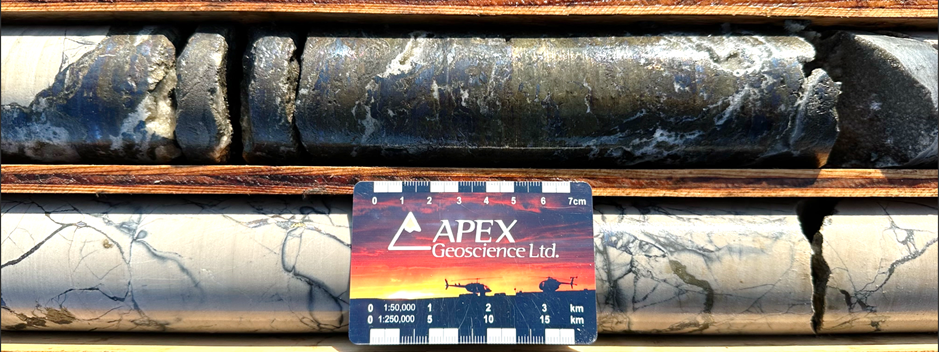
Figure 3: Massive chalcocite (dark gray) and chalcopyrite (brass colored) in drill hole ST23-03 from about 58 m depth.
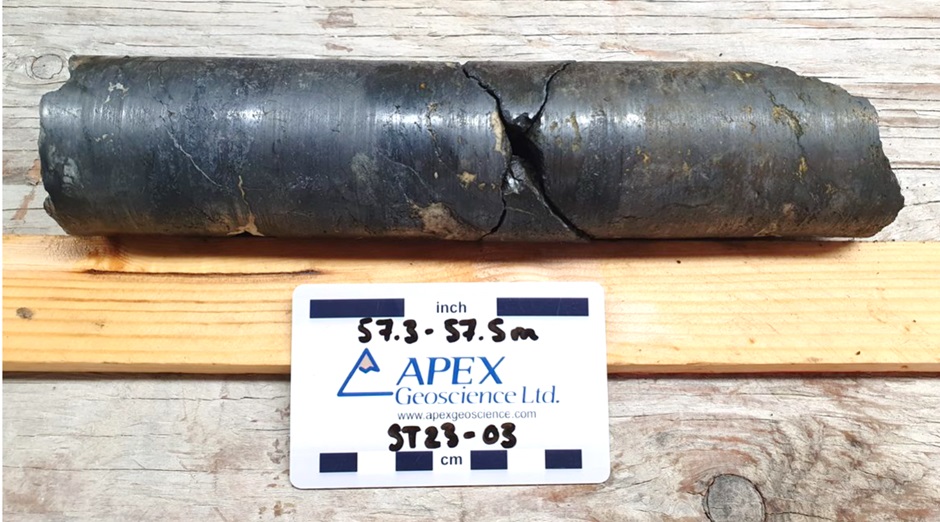
Figure 4: Massive chalcocite (dark gray) in drill hole ST23-03 from about 57.4 m depth.
The lower interval is interpreted to be the same distinct sediment-bound mineralized horizon encountered in diamond drill holes ST22-10, ST23-01 and ST23-02 (Figure 2). Although relatively narrow (~2 m), the presence of strong chalcocite, the mineral common to the core of these sediment-bearing systems, is extremely encouraging.
CONCLUSION: The news behind today’s discovery is that American West appears to have cracked the code on the Storm deposit. The new drill results impressively confirm that the geophysical techniques used are reliable tools for finding copper sulfides at Storm. The size and intensity of the mineralization in the new zone, which has been named “Thunder”, is even more thick and intense than that of the known high-grade 2750N and 2200N zones along strike to the east, which returned as much as 41m at 4.18% Cu in ST22-05 last year. American West geologists now believe that the Southern Graben Fault is the primary source of near surface and deeper copper mineralization. For this reason, the company is already planning additional drilling along the 10-kilometer-long fault structure next spring. In that sense, the discovery at Storm is just getting started. Meanwhile, American West is awaiting further results from ongoing reserve circulation (RC) drilling from the 2750N and 2200N zones. These near-surface copper targets, aswell as the new Thunder zone, could be suitable for open pit mining and direct-shipping ore, respectively. The company also plans to provide an update on this shortly.
Disclaimer: GOLDINVEST Consulting GmbH publishes comments, analyses and news on https://www.goldinvest.de. These contents serve exclusively the information of the readers and do not represent any kind of call to action, neither explicitly nor implicitly they are to be understood as an assurance of possible price developments. Furthermore, they in no way replace an individual expert investment advice, it is rather promotional / journalistic publications. Readers who make investment decisions or carry out transactions on the basis of the information provided here do so entirely at their own risk. The acquisition of securities, especially with shares in the penny stock area, carries high risks, which can lead to a total loss of the invested capital. The GOLDINVEST Consulting GmbH and its authors exclude any liability for financial losses or the content guarantee for topicality, correctness, adequacy and completeness of the articles offered here expressly. Please also note our terms of use.
Pursuant to §34b WpHG (Securities Trading Act) and in accordance with Paragraph 48f (5) BörseG (Austrian Stock Exchange Act) we would like to point out that principals, partners, authors and employees of GOLDINVEST Consulting GmbH hold or may hold shares in American West Metals and therefore a possible conflict of interest exists. We also cannot exclude that other stock letters, media or research firms discuss American West Metals during the same period. Therefore, symmetrical information and opinion generation may occur during this period. Furthermore, there is a consulting or other service contract between American West Metals and GOLDINVEST Consulting GmbH, which means that a conflict of interest exists.






